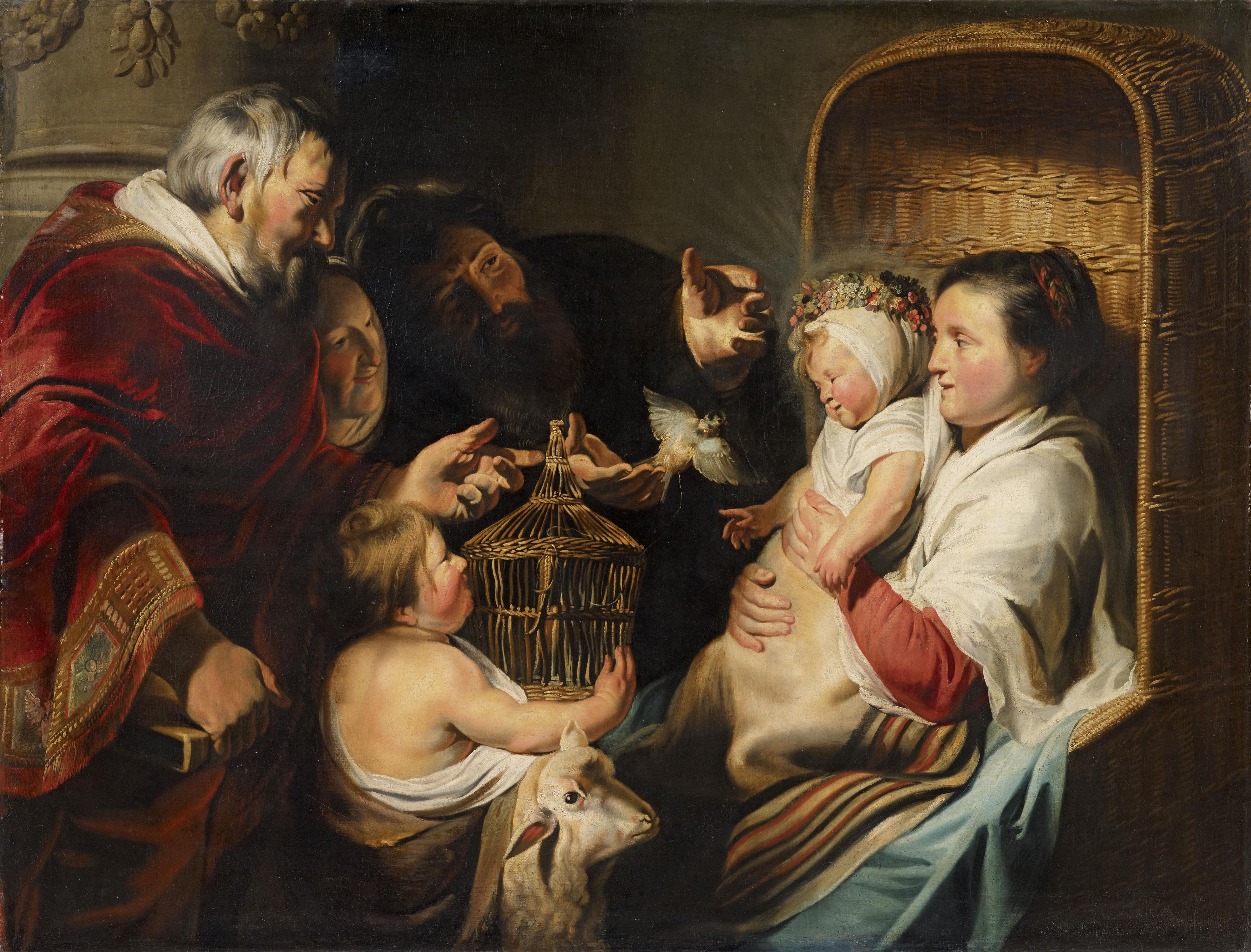Jacob Jordaens
The Holy Family with the Young Saint John and His Parents
Oil on canvas (relined). 112.5 x 148 cm.
Mary sits in a wicker chair with the infant Jesus garlanded with flowers as they receive the young John the Baptist and his parents, the priest Zacharias and Elisabeth; Joseph has also joined the group. This large-format painting was housed in an important Westphalian aristocratic collection for more than 200 years and was not known to art historical researchers in its original form. This led to differing assessments of this work; Michael Jaffé considered it to be the work of Jacob Jordaens himself, while R. A. d'Hulst doubted this. Only Hans Vlieghe was later able to study the painting in the original and confirmed it to be an original work by the young Jacob Jordaens, dating it around 1620 (a time in which, according to Vlieghe, the artist did not yet have his own workshop; cf. expertise of 25.11.2011).
This is the third version of this theme by Jacob Jordaens, after the signed prime version in the North Carolina Museum of Art, Raleigh (fig. 2), and the second in the National Gallery in London, both with approximately the same dimensions as the present painting. As with other popular themes (such as Aesop's fable "The Satyr and the Peasant" or "The Bean Feast"), Jordaens thus also created several versions here. If one compares this most recent version, apart from minor differences, a few striking changes stand out, namely the replacement of the curtain by a column and - most importantly - the addition of the figure of Joseph in the centre of the picture, which is of significance in terms of content and composition. Whereas in the previous versions, the two groups of figures face each other, the addition of Joseph closes the composition into a semicircle - which seems more appropriate to the intimate family theme.
R. A. d'Hulst has described the creative period during which this painting was created as one of "rich unfurling between 1619 and 1627". For the young Jordaens, it was a matter of succeeding on the Antwerp art market with his own pictorial idiom and standing out from the mass of other artists. As with the somewhat younger van Dyck, Rubens, 16 years his senior, was his guiding star. Thus, without Rubens, the monumental, balanced composition of this work is inconceivable, as is the powerful appearance of a figure such as Zacharias in the dark red priestly robe. However, Jordaens' intimate and lifelike depiction of the scene is quite unique and different from Rubens' work. The way in which the adults look at the infant Jesus with rapture; how Mary proudly presents Her newborn to the visitors; how the Child gently holds out His hand to the bird fluttering towards Him - all this is depicted in a way that is so close to life that one thinks one is witnessing a Sunday visit by relatives admiring a new baby. This almost genre-like closeness to life is also evident in details such as the wicker chair (which, like the striped blanket, appears in a series of other paintings) or the birdcage made of small crooked branches, which looks as if little John had made it himself. Looking at the boy Jesus leaning comfortably against His mother's breast, one almost forgets that the goldfinch is actually a symbol of Christ's Passion. How much Jordaens' everyday, true-to-life depictions differ from the art of his great model Rubens is shown in any number of his works, for example with the latter's "Holy Family with St. John and Elizabeth" from the Wallace Collection, whose formal rigour recalls the art of Raphael (fig. 3).
Besides Rubens, it is an Italian artist whose influence can be seen in this painting, namely Caravaggio. Jordaens was able to study his art through the work of Rubens, who knew Caravaggio's paintings from Rome. In addition, there was also a major Caravaggio work to admire in Antwerp, which arrived in the city via a complicated route - namely the altarpiece of the Madonna of the Rosary. It was sold at auction in Amsterdam (together with a Judith and Holofernes, which is still missing) and acquired by a consortium of Flemish artists associated with Rubens for St Paul's Church in Antwerp. Along with Rubens, van Balen and van Dyck, the young Jordaens was one of the artists who contributed a work for the decoration of the church (fig. 4). Caravaggio's influence is revealed here in the dramatic chiaroscuro, for example the bright light falling on Mary and Jesus, the shadowed face of Zacharias or the shadows that form on the hands of Elizabeth and Joseph. Light and shadow bring order and rhythm to the composition and direct the viewer's gaze from left to right. Jordaens also learned from Caravaggio the use of hands and gestures to structure and form a narrative (a central element of the Madonna of the Rosary), as seen here in the centre of the picture with Zacharias, Elisabeth and Joseph.
Thus, all of the central aspects of the young Jordaen's œuvre come together in this painting: his confrontation with the great artistic models Rubens and Caravaggio and his striving for his own pictorial language, combining monumentality and closeness to life. Thus, the painting is exemplary for the beginning of Jordaens' creative phase of "rich development".
Certificate
Hans Vlieghe, Bonheiden, 25.11.2011.
Provenance
The painting was in the collection of the noble family J. zur Mühlen (Westphalia) since the 18th century. - Since then in family possession. - 1000. Lempertz-Auktion, Köln, 17.11.2012, Lot 1134. - West German private collection.
Literature
Michael Jaffé: Jacob Jordaens 1593 - 1678, The National Gallery of Canada, Ottawa 1968. p. 74 -75. - R. A. d´Hulst: Jacob Jordaens (exhibition catalogue), Antwerp 1993, p. 70-72,ill. 11.
Exhibitions
Münster: Meisterwerke Holländischer und Flämischer Malerei aus Westfälischen Privatbesitz,1939, no. 29, plate XII. - Aachen: Ausstellung Flämischer und Holländischer Gemälde aus Aachner Privatbesitz, 1955, no. 45, ill. no. 7.

